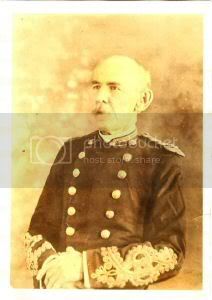Admiral Richard Wainwright

Richard Wainwright was born in Washington, DC, on the 17th of December, 1849.
He was appointed to the United States Naval Academy by the President at-large on 28th September 1864, and graduated in 1868.
Wainwright also earned a Law Degree, from Columbian (now George Washington) University, in 1884, and a Doctorate in Law, in 1900.
He was executive officer on board the battleship Maine when she blew up in the harbour of Havana, Cuba, on 15th February 1898. Surviving the explosion, he was assigned to command of the tender Fern and was in charge of the recovery of the bodies of the victims. He also assisted in the collection of information for the subsequent court of inquiry.
Wainwright later commanded the gunboat Gloucester at the Battle of Santiago de Cuba on 3 July 1898. In this engagement, Gloucester sank one Spanish torpedo boat and drove another on the beach, he then rescued Admiral Cevera and 200 officers and men from the burning flagship Infanta Maria Teresa, and part of crew of Almirante Oquento. Wainwright was commended for his valor in this enragement and was advanced ten numbers in rank "for eminent and conspicuous conduct in this battle." He was presented with a silver loving cup by the citizens of Gloucester, Massachusetts and a sword by the citizens of Washington, DC.
Later, promoted to Rear Admiral, he commanded the USS Louisiana and the Second Division of the United States Atlantic Fleet during the cruise of The Great White Fleet.
His son also called Richard Wainwright also served on the USS Louisiana on the cruise of The Great White Fleet and he later became Commander Richard Wainwright and the recipient of a Medal of Honor citation.
Retired from active duty on 7 December 1911, Admiral Wainwright died in Washington, D.C. on the 5th March, 1926. He is buried in Section 3 of Arlington National Cemetery with his wife, Evelyn Wotherspoon Wainwright.
The next instalment will cover the USS Minnesota
Regards
Sean









